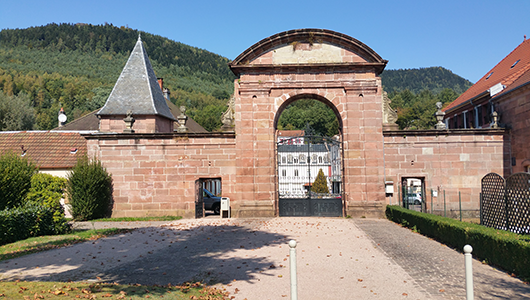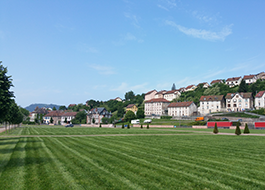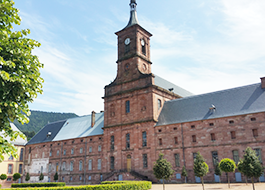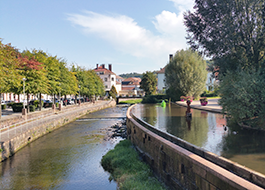Moyenmoutier
Durée visite : 45 minutes
Moyen : Pédestre
Le site est un point de passage de la Voie des Saulniers gallo-romaine. L’étymologie du nom de la commune provient évidemment de l’abbaye de Moyenmoutier. Le monastère ou moustier, est fondé en 671 par saint Hydulphe. Il était à mi-distance de ceux de Senones à l’Est, d’Étival à l’Ouest, de Saint-Dié au Sud et de Bonmoutier au Nord. Cet ensemble forme la croix sacrée de Lorraine, ou croix monastique des Vosges. La Révolution française sonne le glas de la vie monacale. Le bruit des machines remplace le chant des moines. La commune connaît une époque prospère au XIXe siècle et au début du XXe, grâce à l’industrie textile. Celle-ci est importée ici en 1806 par un anglais, John Heywood, pionnier du coton dans les Vosges. Ses installations industrielles seront ensuite reprises par la société de la famille Seillière, puis par Ponnier et Cie, sociétés également propriétaires d’établissements similaires à Senones. La crise de ce secteur a entraîné un net recul démographique. 1500 habitants en 1800, 5100 en 1910, 3200 en 2016. En 14-18, la commune sera sous le feu des bombardements allemands. Plusieurs civils sont victimes de ces faits de guerre. 250 noms d’enfants de la commune figurent sur le monument aux morts. En 1940-45, exécutions et déportations touchent moins Moyenmoutier que ses voisines.
The site is a crossing point of the Gallo-Roman Saulnier Way. The etymology of the name of the town obviously comes from the Abbey of Moyenmoutier. The monastery or moustier, is founded in 671 by saint Hydulphe. It was halfway between Senones to the east, Étival to the west, Saint-Dié to the south and Bonmoutier to the north. This set forms the sacred cross of Lorraine, or monastic cross of the Vosges. The French Revolution sounds the death knell of monastic life. The sound of the machines replaces the singing of the monks. The town has a prosperous era in the nineteenth century and early twentieth, thanks to the textile industry. It is imported here in 1806 by an Englishman, John Heywood, a pioneer of cotton in the Vosges. Its industrial facilities will then be taken over by the family company Seillière, then by Ponnier et Cie, companies also owners of similar establishments in Senones. The crisis in this sector has led to a sharp demographic decline. 1500 inhabitants in 1800, 5100 in 1910, 3200 in 2016. In 14-18, the town will be under fire from German bombing. Many civilians are victims of these war events. 250 names of children from the town are on the war memorial. In 1940-45, executions and deportations affect less Moyenmoutier than its neighbors.
Die Stätte ist eine Kreuzung des gallo-römischen Saulnierweges. Die Etymologie des Namens der Stadt stammt offensichtlich aus der Abtei von Moyenmoutier. Das Kloster oder Moustier wurde 671 vom Heiligen Hydulphe gegründet. Es war auf halbem Weg zwischen Senones im Osten, Étival im Westen, Saint-Dié im Süden und Bonmoutier im Norden. Dieser Satz bildet das heilige Kreuz Lothringens oder das Kloster der Vogesen. Die Französische Revolution ist der Todesstoß des klösterlichen Lebens. Der Klang der Maschinen ersetzt den Gesang der Mönche. Dank der Textilindustrie hat die Stadt im 19. und frühen 20. Jahrhundert eine blühende Epoche. Es wird hier im Jahre 1806 von dem Engländer John Heywood, einem Pionier der Baumwolle in den Vogesen, importiert. Die Industrieanlagen werden dann von dem Familienunternehmen Seillière übernommen, dann von Ponnier et Cie, die ebenfalls Eigentümer ähnlicher Betriebe in Senones sind. Die Krise in diesem Sektor hat zu einem starken demografischen Rückgang geführt. 1500 Einwohner im Jahr 1800, 5100 im Jahr 1910, 3200 im Jahr 2016. In 14-18 wird die Stadt von deutschen Bombenangriffen beschossen. Viele Zivilisten sind Opfer dieser Kriegsereignisse. Auf dem Kriegerdenkmal stehen 250 Namen von Kindern aus der Stadt. Exekutionen und Deportationen betreffen 1940 weniger Moyenmoutier als seine Nachbarn.

D’azur au dextrochère de carnation vêtu d’argent tenant une crosse abbatiale d’or, avec son sudarium d’argent.
Ces armoiries sont celles de l’abbaye de Moyenmoutier. Cette abbaye créée en 671 par Saint Hidulphe, archévêque de Trèves, était l’une des plus riches des Vosges.
These coats of arms are those of the Moyenmoutier abbey. This abbey, created in 671 by Saint Hidulphe, archbishop of Trier, was one of the richest in the Vosges.
Diese Wappen sind die der Abtei Moyenmoutier. Diese Abtei, die 671 vom Heiligen Hidulphe, Erzbischof von Trier, gegründet wurde, war eine der reichsten der Vogesen.

Les habitants et les habitantes de Moyenmoutier s’appellent les Médianimonastériens et les Médianimonastériennes.
The inhabitants of Moyenmoutier are called the Médianimonastériens and the Médianimonasteriennes.
Die Einwohner von Moyenmoutier heißen Médianimonastériens und Médianimonasteriennes.
Les points de visites
.
Un jardin a existé de 1776 à la Révolution. Devenu, comme l’ensemble de l’abbaye, bien national, il a été recouvert par une usine textile, disparue en 2003. En 2012, la restauration du parc a suivi le plan simple et austère de son prédécesseur. La trame orthogonale adoptée dans le projet fait écho au dessin de la façade de l’abbaye. L’organisation tourne autour de de trois pôles : jardin des plantes médicinales, verger et espace de loisirs. Le jardin des simples est dédié aux plantes médicinales. Elles sont classées selon les maladies qu’elles traitent. Un théâtre de verdure accueille des spectacles. A l’arrière de l’abbaye se trouve un autre jardin. Il évoque l’ancien cloître.
A garden existed from 1776 to the Revolution. Become, like the whole of the abbey, well national, it was covered by a textile factory, disappeared in 2003. In 2012, the restoration of the park followed the simple and austere plan of its predecessor. The orthogonal grid adopted in the project echoes the design of the abbey facade. The organization revolves around three poles: medicinal plants garden, orchard and leisure area. The garden of the simples is dedicated to medicinal plants. They are classified according to the diseases they treat. A green theater hosts shows. At the back of the abbey is another garden. It evokes the old cloister.
Ein Garten existierte von 1776 bis zur Revolution. Sie wurde, wie die gesamte Abtei, gut national, sie wurde von einer Textilfabrik bedeckt und war 2003 verschwunden. Im Jahr 2012 folgte die Wiederherstellung des Parks dem einfachen und strengen Plan seines Vorgängers. Das im Projekt verwendete orthogonale Raster spiegelt die Gestaltung der Fassade der Abtei wider. Die Organisation dreht sich um drei Pole: Heilpflanzengarten, Obstgarten und Freizeitbereich. Der Garten der Simples ist Heilpflanzen gewidmet. Sie werden nach den von ihnen behandelten Krankheiten klassifiziert. Ein grünes Theater veranstaltet Shows. An der Rückseite der Abtei befindet sich ein weiterer Garten. Es erinnert an den alten Kreuzgang.
.
.
L’abbaye Saint-Hydulphe était une abbaye de l’ordre de Saint-Benoît. Elle fut fondée vers l’an 671. Vers 915, les Hongrois pillent et incendient une partie des bâtiments de l’abbaye. Le monastère ruiné reste abandonné plusieurs années. Il faut attendre 960 pour qu’une deuxième abbaye soit reconstruite. Depuis Gérard d’Alsace au milieu du XIe siècle, l’abbaye de Moyenmoutier fait partie de la souveraineté des ducs de Lorraine. En 1535, l’abbaye est régie en commende. Les laïcs alliés aux ducs de Lorraine administrent l’abbaye, négligeant la vie spirituelle et ne pensant que tirer profit des bénéfices. Les moines s’affranchissent notamment de la tonsure. C’est pendant cette période que l’abbaye s’occupe des procès en sorcellerie. Entre 1572 et 1618, il y a 38 procès se soldant par 21 exécutions au bûcher. Une profonde réforme est entreprise au XVIIe siècle. Vers 1700, une académie des sciences est créée. Moines théologiens, historiens, naturalistes, archéologues, entomologistes, médecins, on retrouve à l’abbaye l’élite savante de l’ordre bénédictin. La bibliothèque compte 11 000 volumes à cette époque. Dom Calmet passe 8 ans à Moyenmoutier. Il y écrit des ouvrages de bibliologie. La construction d’une nouvelle abbaye est entreprise sur le site actuel à partir de 1767, alors même que la précédente abbaye venait d’être reconstruite. Pourquoi une nouvelle abbaye sur un nouveau site ? La question reste à ce jour sans réponse. C’est cette troisième abbaye que l’on peut admirer aujourd’hui. Elle est le plus bel édifice baroque de Lorraine. L’histoire des bénédictins à l’abbaye de Moyenmoutier se termine avec le départ des moines au cours de l’année 1791. Le site, vendu comme bien national, devient l’ entreprise textile de John Heywood. Passée aux Sellière, elle prospère au XIXe siècle. En 1920, l’affaire est rachetée par le groupe Boussac. L’usine de Moyenmoutier emploie jusque 800 personnes. En 1989, la commune de Moyenmoutier acquiert l’abbaye. Toutefois elle reste une coquille vide. L’usine ruinée laisse la place au parc. Les bâtiments conventuels attendent toujours leur réhabilitation intérieure.
The abbey Saint-Hydulphe was an abbey of the order of Saint-Benoît. It was founded around the year 671. Around 915, the Hungarians looted and burned part of the abbey’s buildings. The ruined monastery remains abandoned for several years. It was not until 960 that a second abbey was rebuilt. Since Gerard of Alsace in the middle of the eleventh century, the Abbey of Moyenmoutier is part of the sovereignty of the Dukes of Lorraine. In 1535, the abbey is governed by commende. The laity, allied with the dukes of Lorraine, administer the abbey, neglecting the spiritual life and thinking only of taking advantage of the benefits. The monks are especially free of tonsure. It is during this period that the abbey deals with witchcraft trials. Between 1572 and 1618, there were 38 trials resulting in 21 executions at the stake. A deep reform is undertaken in the seventeenth century. Around 1700, a science academy was created. Monks theologians, historians, naturalists, archaeologists, entomologists, doctors, we find at the abbey the scholarly elite of the Benedictine order. The library has 11,000 volumes at this time. Dom Calmet spends 8 years in Moyenmoutier. He writes bibliology books. The construction of a new abbey is undertaken on the current site from 1767, even though the previous abbey had just been rebuilt. Why a new abbey on a new site? The question remains unanswered. It is this third abbey that we can admire today. It is the most beautiful baroque building in Lorraine. The history of the Benedictines at the Abbey of Moyenmoutier ends with the departure of the monks during the year 1791. The site, sold as national property, becomes the textile company of John Heywood. Passed to Sellière, it thrives in the nineteenth century. In 1920, the business was bought by the Boussac group. The factory in Moyenmoutier employs up to 800 people. In 1989, the commune of Moyenmoutier acquires the abbey. However, it remains an empty shell. The ruined factory gives way to the park. Conventual buildings are still waiting for their internal rehabilitation.
Die Abtei Saint-Hydulphe war eine Abtei im Auftrag von Saint-Benoît. Sie wurde um das Jahr 671 gegründet. Gegen 915 plünderten und brannten die Ungarn einen Teil der Gebäude der Abtei. Das zerstörte Kloster bleibt für mehrere Jahre verlassen. Erst 960 wurde eine zweite Abtei wieder aufgebaut. Seit Gerard von Elsass in der Mitte des elften Jahrhunderts gehört die Abtei von Moyenmoutier zur Souveränität der Herzöge von Lothringen. Im Jahr 1535 wird die Abtei vom Kommandanten regiert. Die mit den Herzögen von Lothringen verbündeten Laien verwalten die Abtei, vernachlässigen das geistige Leben und denken nur daran, die Vorteile zu nutzen. Die Mönche sind besonders tonlos. In dieser Zeit beschäftigt sich die Abtei mit Hexereiprozessen. Zwischen 1572 und 1618 gab es 38 Prozesse, die zu 21 Hinrichtungen führten. Im 17. Jahrhundert wird eine tiefgreifende Reform vorgenommen. Um 1700 wurde eine Wissenschaftsakademie gegründet. Mönche Theologen, Historiker, Naturwissenschaftler, Archäologen, Entomologen, Ärzte, wir finden in der Abtei die gelehrte Elite des Benediktinerordens. Die Bibliothek verfügt derzeit über 11.000 Bände. Dom Calmet verbringt 8 Jahre in Moyenmoutier. Er schreibt bibliologische Bücher. Der Bau einer neuen Abtei wird ab 1767 an der jetzigen Stätte durchgeführt, obwohl die vorherige Abtei gerade umgebaut wurde. Warum eine neue Abtei an einem neuen Ort? Die Frage bleibt unbeantwortet. Diese dritte Abtei können wir heute bewundern. Es ist das schönste Barockgebäude Lothringens. Die Geschichte der Benediktiner in der Abtei von Moyenmoutier endet mit dem Abzug der Mönche im Jahre 1791. Die als nationales Gut verkaufte Stätte wird zur Textilfirma von John Heywood. An Sellière übergeben, gedeiht sie im 19. Jahrhundert. Im Jahr 1920 wurde das Unternehmen von der Boussac-Gruppe gekauft. Die Fabrik in Moyenmoutier beschäftigt bis zu 800 Mitarbeiter. 1989 erwirbt die Gemeinde Moyenmoutier die Abtei. Es bleibt jedoch eine leere Hülle. Die zerstörte Fabrik weicht dem Park. Konventuelle Gebäude warten immer noch auf ihre interne Sanierung.
.
.
De 25,7 km de longueur, le Rabodeau naît au col de Prayé, au sud-ouest du massif du Donon. Son parcours, régulièrement orienté ouest-sud-ouest, est parallèle à celui de la Plaine. Dans la partie amont de son cours, le Rabodeau a un caractère torrentiel, marqué par des cascades. Le Rabodeau rejoint la Meurthe à Moyenmoutier. Le Rabodeau fait partie du bassin de la Haute-Meurthe, où fut pratiqué pendant des siècles le flottage du bois. Le flottage dans le massif vosgien se faisait par trains de grumes ou de planches. Le boloyage fut aussi employé. Une bollée en patois vosgien est une expédition de flottage à bûches perdues. Les pièces de bois étaient jetées dans la rivière pendant les hautes eaux. Cela facilitait la descente avec le courant grâce à des petits barrages ou vannes qu’on ouvrait. On gonflait ainsi le flot jusqu’au port d’arrivage qui était à Raon-l’Étape. Ces dispositifs favorisèrent l’installation et le développement du textile dans la vallée, grâce à l’énergie hydraulique. Le chemin de fer du Rabodeau desservait la vallée. Il mit fin au flottage dans la vallée du Rabodeau. Il fut construit en 1872 sous l’impulsion des industriels, par la Société anonyme du chemin de fer d’Étival à Senones. Il participa à l’essor de l’économie textile et papetière. La ligne fut fermée en 1982. Un circuit à vélo suit son tracé.
The Rabodeau is 25.7 km long and is born at the Prayé pass, south-west of the Donon massif. Its course, regularly oriented west-southwest, is parallel to that of the Plain. In the upstream part of its course, the Rabodeau has a torrential character, marked by cascades. The Rabodeau joins the Meurthe in Moyenmoutier. The Rabodeau is part of the basin of the Haute-Meurthe, where was practiced for centuries the floating of wood. Floating in the Vosges mountains was done by trains of logs or planks. The bowl was also used. A bollée in Vosgian patois is a lost log rafting expedition. The pieces of wood were thrown into the river during high water. This facilitated the descent with the current through small dams or valves that were opened. The flow was thus inflated to the port of arrival which was at Raon-l’Etape. These devices favored the installation and development of the textile in the valley, thanks to hydraulic energy. The Rabodeau railway served the valley. He put an end to the floating in the Rabodeau valley. It was built in 1872 under the impetus of industrialists, by the anonymous railway company from Étival to Senones. He participated in the development of the textile and paper economy. The line was closed in 1982. A bicycle tour follows its route.
Der Rabodeau ist 25,7 km lang und wurde am Prayé-Pass südwestlich des Donon-Massivs geboren. Sein Verlauf, der regelmäßig nach Westen und Südwesten ausgerichtet ist, verläuft parallel zu dem der Ebene. Im stromaufwärtigen Teil des Flusses hat der Rabodeau einen torrentiellen Charakter, der durch Kaskaden gekennzeichnet ist. Das Rabodeau schließt sich der Meurthe in Moyenmoutier an. Der Rabodeau ist Teil des Beckens der Haute-Meurthe, wo seit Jahrhunderten das Schweben von Holz praktiziert wird. Das Schwimmen in den Vogesen erfolgte durch Holz- oder Plankenzüge. Die Schüssel wurde auch verwendet. Eine Bollée im vosgianischen Patois ist eine verlorene Floßexpedition. Die Holzstücke wurden während des Hochwassers in den Fluss geworfen. Dies ermöglichte den Abstieg mit dem Strom durch kleine Dämme oder Ventile, die geöffnet wurden. Die Strömung wurde somit bis zum Ankunftshafen in Raon-l’Etape aufgeblasen. Diese Geräte begünstigten dank hydraulischer Energie den Einbau und die Entwicklung des Textils im Tal. Die Rabodeau-Bahn diente dem Tal. Er hat dem Schwimmen im Rabodeau-Tal ein Ende gesetzt. Es wurde 1872 unter dem Anstoß von Industriellen von der anonymen Eisenbahngesellschaft von Étival nach Senones erbaut. Er beteiligte sich an der Entwicklung der Textil- und Papierwirtschaft. Die Strecke wurde 1982 geschlossen. Eine Fahrradtour folgt ihrer Route.








